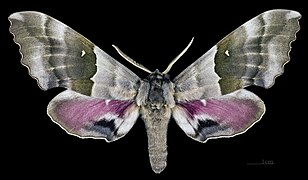Pachysphinx modesta
| Pachysphinx modesta | ||||||||||||
|---|---|---|---|---|---|---|---|---|---|---|---|---|

Pachysphinx modesta |
||||||||||||
| Systematics | ||||||||||||
|
||||||||||||
| Scientific name | ||||||||||||
| Pachysphinx modesta | ||||||||||||
| ( Harris , 1839) |
Pachysphinx modesta is a butterfly ( moth ) from the family of moth (Sphingidae).
features
butterfly
The moths have a fore wing length of 43 to 60 millimeters. They are similar to the slightly larger Pachysphinx occidentalis . Both species have wavy outer edges on the forewings, a contrasting dark color on the medial area of the forewings and reddish hindwings with a striking blue markings in the anal angle. The basic color of Pachysphinx modesta is more mouse gray, whereas Pachysphinx occidentalis is much lighter yellowish brown. The blue markings on the hind wings of Pachysphinx modesta are partially covered by a black triangle. In Pachysphinx occidentalis this pattern is much lighter and divided by two black lines. The color of the moths is variable. Most individuals from the northeastern United States and the Great Lakes region have very dark gray forewings, in which the contrasting pattern is greatly reduced. There may be regional variations in the coloration, especially in the west and south of the range of the species.
Caterpillar
The caterpillars of Pachysphinx modesta can be distinguished from those of Pachysphinx occidentalis by two fairly uniform characteristics. In the last stage the caterpillars of Pachysphinx modesta are covered with small, white setae , which the similar species lacks. In addition, the anal horn of Pachysphinx occidentalis is at least twice as long as that of Pachysphinx modesta .
Doll
The pupa is colored chestnut brown to almost black. It is relatively large and has a slightly granulated surface. The proboscis is fused with the body. The cremaster is quite short, wide and has a blunt tip.
egg
The eggs are similar to those of the peacock moth (Saturniidae) and are large, round and somewhat flattened. They are initially gray-green with a pink tint, but turn more green as the caterpillar develops.
Occurrence
The species is widespread in large parts of North America. It is common in the Great Lakes region of the United States and Canada. In the east, the species occurs north to Prince Edward Island, Nova Scotia, in most of Quebec and Newfoundland and in Ontario. Evidence exists south to Florida and Texas, but the species is much rarer in the south. Still, it's fairly common in Victoria County, Texas. In western Canada, the species has been recorded north to The Pas in Manitoba, Jan Lake in Saskatchewan, Gregoire Lake , Alberta and in southern British Columbia. The species can be common in eastern Washington and Oregon and along the eastern foothills of the Rocky Mountains in Colorado and Utah.
The animals are widespread in the east and north of their range, as their food plants are just as widespread. Further to the west, the species is restricted to the banks of waters.
Way of life
The moths often fly to artificial light sources at night. Females react shortly after dusk, while males are mainly active shortly before midnight. The proboscis is very short and the head muscles that would be needed for sucking are poorly developed. The moths therefore presumably do not ingest any food. Pachysphinx modesta flies in large parts of its range from late May to early July. In the north there is one generation per year, from Missouri and further south there are apparently two generations per year.
Food of the caterpillars
The caterpillars feed on a multitude of different species of willow family (Salicaceae), but locally individual populations may prefer certain plant species. Although willows ( Salix ) have long been mentioned in the literature as important food plants, rearing them does not seem to be successful, at least for caterpillars from some areas. Poplars ( Populus ) seem to be accepted as an alternative much more common.
development
The females lay their eggs in small groups of three to ten. The caterpillars hatch after about a week. Some caterpillars eat the egg shell after hatching. They spread quickly and then live as loners. They rest along the midrib of the leaves of their food plants during all stages. They usually only cling to the last two belly legs and show the defensive posture typical of enthusiasts with an upright front body part. Pupation takes place in a chamber a few centimeters deep in the ground.
supporting documents
Individual evidence
- ↑ a b c d e f g h i James P. Tuttle: The Hawkmoths of North America, A Natural History Study of the Sphingidae of the United States and Canada. The Wedge Entomological Research Foundation, Washington, DC 2007, ISBN 978-0-9796633-0-7 , p. 126 ff.
literature
- James P. Tuttle: The Hawkmoths of North America, A Natural History Study of the Sphingidae of the United States and Canada. The Wedge Entomological Research Foundation, Washington, DC 2007, ISBN 978-0-9796633-0-7 .



